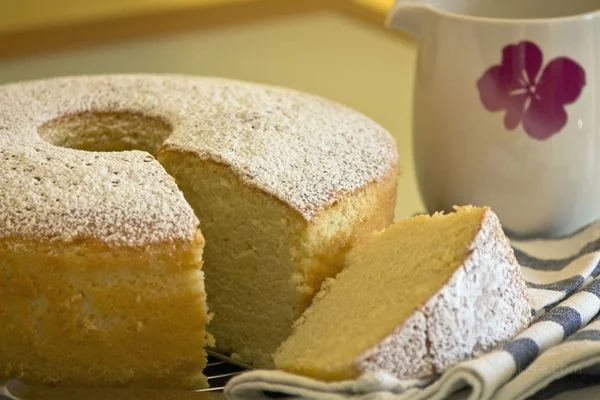Chiffon cake is a light and airy dessert known for its fluffy texture and delicate flavor. One of the key components to achieving the perfect chiffon cake is using a tube pan during the baking process.

What is Chiffon Cake?
Before delving into the role of a tube pan in chiffon cake baking, let’s briefly discuss what chiffon cake is. This delightful cake was invented in the late 1920s by a Californian named Harry Baker.
It quickly gained popularity due to its unique texture and versatile flavor profile. Chiffon cake can be flavored with various extracts, such as vanilla, citrus, or chocolate, making it a versatile dessert that appeals to many palates.
The Role of Tube Pan in Chiffon Cake Baking
Definition and Purpose of a Tube Pan
A tube pan, also known as an angel food cake pan, is a round baking pan with a hollow tube in the center. It is typically made of aluminum or stainless steel and comes in various sizes.
The tube in the center allows heat to reach the center of the cake more efficiently, promoting even baking.
How Tube Pan Affects the Baking Process
When baking chiffon cake, the tube pan plays a crucial role in achieving the desired texture and structure. Its unique design helps create an environment that is conducive to producing a light and fluffy cake.
Why Does Chiffon Cake Need a Tube Pan?
Ensuring Even Heat Distribution
One of the primary reasons why chiffon cake requires a tube pan is to ensure even heat distribution during baking.
The tube in the center allows the heat to penetrate the cake from the inside, ensuring that it bakes evenly throughout. Without a tube pan, the center of the cake may remain undercooked, leading to an uneven texture and compromised taste.
Promoting Proper Air Circulation
Chiffon cake relies on beaten egg whites to incorporate air into the batter, creating a light and airy texture.
The tube in the pan allows the batter to rise and expand uniformly while baking, ensuring proper air circulation. This promotes the formation of delicate air pockets throughout the cake, resulting in its signature fluffy texture.
Supporting the Cake Structure
Chiffon cake is delicate and tender, and it requires external support to maintain its structure while baking. The tube pan provides the necessary support for the cake to rise properly without collapsing.
As the cake bakes and sets, it clings to the sides of the pan and maintains its height and shape.
Tips for Using a Tube Pan for Chiffon Cake Baking
To ensure successful chiffon cake baking using a tube pan, consider the following tips:
Preparing the Tube Pan
Before using a tube pan for chiffon cake, it’s essential to properly prepare it to prevent sticking and ensure an even bake.
Start by greasing the entire inside surface of the pan, including the tube and the sides, with a thin layer of butter or cooking spray. This will help the cake release easily after baking.
Ensuring the Batter Fills the Pan Correctly
When pouring the chiffon cake batter into the tube pan, fill it only about three-fourths of the way. Chiffon cake needs space to rise and expand during baking, and if the pan is filled to the brim, it may overflow or collapse. Leave some room for the cake to grow while maintaining its structure.
Inverting the Cake After Baking
Once the chiffon cake is baked, it is crucial to cool it upside down in the tube pan. This may seem unusual, but it’s necessary to prevent the cake from collapsing. The inverted position helps the cake maintain its height and prevents it from sinking in the middle. You can use the pan’s legs or a bottle neck to elevate it while it cools upside down.
Alternative Pans for Chiffon Cake
While a tube pan is the preferred choice for baking chiffon cakes, there are alternative pans that can be used if a tube pan is not available. One option is an angel food cake pan, which is similar to a tube pan but lacks the removable bottom.
Another alternative is a bundt pan, which has intricate designs but may not provide as even heat distribution as a tube pan. However, keep in mind that using alternative pans may slightly affect the texture and appearance of the final cake.
FAQs
While it is possible to use a regular round cake pan, it may result in an unevenly baked cake with a denser texture. A tube pan is specifically designed to produce the desired light and fluffy chiffon cake.
The size of the tube pan will depend on the recipe and the desired yield of your chiffon cake. Common sizes range from 9 to 10 inches in diameter. Follow the recipe instructions for the recommended pan size.
No, it is important to cool the chiffon cake while still in the tube pan. Inverting the pan and cooling the cake upside down allows it to maintain its structure and prevents it from collapsing.
To prevent sticking, make sure to thoroughly grease the inside of the tube pan with butter or cooking spray before pouring in the batter. This will help the cake release easily after baking.
It is generally recommended to use a traditional aluminum or stainless steel tube pan for chiffon cake. Silicone pans may not provide the same heat conductivity and may result in an unevenly baked cake.
Conclusion
In conclusion, a tube pan is a vital tool for baking a perfect chiffon cake. Its unique design ensures even heat distribution, promotes proper air circulation, and supports the cake’s structure.
By using a tube pan correctly and following the tips mentioned, you can achieve a light, fluffy, and delicious chiffon cake every time.
